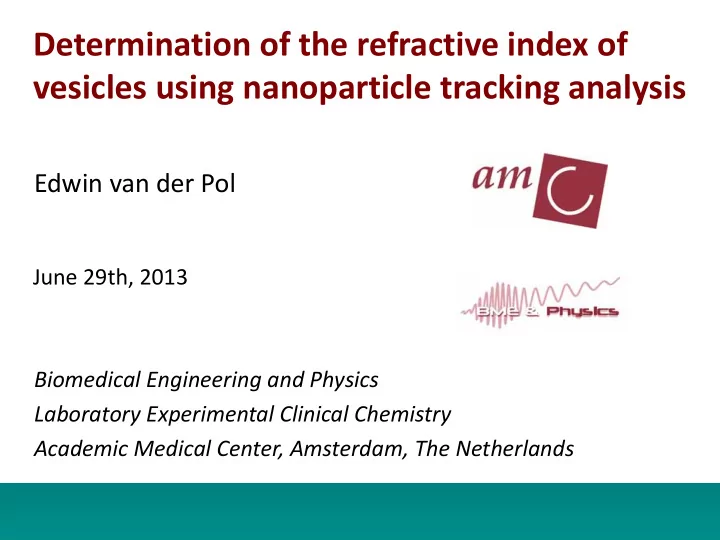

Determination of the refractive index of vesicles using nanoparticle tracking analysis Edwin van der Pol June 29th, 2013 Biomedical Engineering and Physics Laboratory Experimental Clinical Chemistry Academic Medical Center, Amsterdam, The Netherlands
Disclosures of: Edwin van der Pol Employment No conflict of interest to disclose Research support No conflict of interest to disclose Scientific advisory board No conflict of interest to disclose Consultancy No conflict of interest to disclose Speakers bureau No conflict of interest to disclose Major stockholder No conflict of interest to disclose Patents No conflict of interest to disclose Honoraria No conflict of interest to disclose Travel support No conflict of interest to disclose Other No conflict of interest to disclose Presentation includes discussion of the following off-label use of a drug or medical device: N/A
Introduction to light scattering light illuminating a vesicle is partly absorbed and partly scattered (deflected) light scattering depends on size and refractive index 3
Introduction to the refractive index M .C. Escher the refractive index is defined as n c vacuum v / medium affects refraction and reflection 4
Motives of studying the refractive index water (n = 1.34) vesicle* (n = 1.4?) lipid (n = 1.45 ‐ 1.50) protein (n = 1.53 ‐ 1.60) polystyrene (n = 1.61) 200 nm new label ‐ free parameter cellular origin distinguish vesicles from contamination relate light scattering to vesicle diameter detection range * Konokhova et al., J. Biomed. Opt. (2012) 5
Nanoparticle tracking analysis (NTA) Concentration (mL ‐ 1 ) Diameter (nm) determine size and concentration of vesicles additional parameters: light scattering or fluorescence Video by Chris Gardiner 6
Method – measure light scattering by NTA no pixel saturation video processing by NanoSight NTA 2.3 intensity corrected for camera shutter time and gain 7
Scattering power versus diameter of beads 8
Scattering power versus diameter of beads 9
Scattering power versus diameter of beads 10
Scattering power versus diameter of beads 11
Scattering power versus diameter of beads 12
Validate method using beads 203 ‐ nm polystyrene beads 90 ‐ nm silica beads Accuracy: 1% Accuracy: 3% Coefficient of variation: 3% Coefficient of variation: 5% 13
Scattering power versus diameter of vesicles 14
Refractive index distribution of vesicles by NTA Urine vesicles Plasma vesicles n = 1.36 n = 1.49 15
Conclusions NTA can be used to assess the refractive index new reference materials have to be developed to calibrate optical instruments for vesicle detection AS 14.2, Tuesday 13:45, Mondriaan II: 16 Physical interpretation of the size and concentration of vesicles
Acknowledgements Academic Medical Center University of Oxford Mitra Almasian Chris Gardiner René Berckmans University of Birmingham Anita Böing Paul Harrison Frank Coumans NanoSight Ltd. Anita Grootemaat Patrick Hole Najat Hajji Andrew Malloy Chi Hau Jonathan Smith Richelle Hoveling Ton van Leeuwen More on microparticle detection: Rienk Nieuwland edwinvanderpol.com Marianne Schaap Guus Sturk Aude Vernet Yuana Yuana 17
Recommend
More recommend